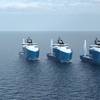Pioneer Marine Sink Deeper into the Red
Pioneer Marine Inc. and its subsidiaries (OSLO-OTC: PNRM) ("Pioneer Marine," or the "Company") a leading shipowner and global drybulk handysize transportation service provider announced its financial and operating results for the first quarter ended March 31, 2016.
Financial Highlights:
For the first quarter of 2016 the Company reported a net loss of $13.9 million, or $0.46 basic and diluted per share which includes charges amounting to $8.7 million as a result of the termination of five newbuilding contracts (“newbuilding contract termination agreement”).
Excluding these charges, the Company’s adjusted net loss for the first quarter of 2016 is $5.3 million or $0.17 per share basic and diluted.
Liquidity & Capital Resources:
As of March 31, 2016, the Company had cash and cash equivalents of $43.8 million and restricted cash of $12.5 million. The Company’s commitments on its newbuilding program amount to $30.1 million which will be funded from committed loan facilities available on delivery of the newbuildings and from existing cash and cash equivalents.
Recent events:
Within Q2 2016 the Company received an amount of $44.4 million representing all instalments paid for the construction of the eight cancelled newbuildings and the interest as per newbuilding contract termination agreement.
Pankaj Khanna, Chief Executive Officer, commented, "Drybulk freight rates in the first quarter of 2016 proved to be the worst experienced over the previous four decades. The major difference being that in the 1980s operating costs were half of what they are today so the ships were still cash flow positive. In the first quarter Owners were virtually paying charterers to move their cargo with some fixtures for Capesize vessels being done at close to zero TCE rates as owners were just paid for bunkers. The weakness in freight rates was mainly a result of anaemic demand and excess supply built over the previous years compounded by an increase in speed for some of the smaller vessels.
“The extreme weakness in freight rates has produced an almost immediate response on scrapping with 18.3 million tonnes sold for scrap as of early May resulting in net fleet growth of 0.3% so far this year. In addition, some owners have also chosen to idle or lay-up their vessels in hot, warm or cold lay-up, further depleting the fleet. The other big positive is that we have seen virtually zero newbuilding orders this year. During this period, we have also seen the return of port congestion at grain load ports in Brazil and Argentina, who combined exported a record 44.3 million tonnes in Q1 2016, up 19% on Q1 2015. On the demand side, the rise in real estate prices in China along with various stimulus measures provided a fillip to steel consumption and consequently prices. Chinese steel production showed its first year-on-year increase in March and iron ore imports into China for the first four months of 2016 are up 6% as compared to 2015. Freight rates in Q2 2016 have responded to these positive changes but remain barely above operating costs and have so far stagnated at this level. The industry still needs concerted scrapping of older tonnage before we see a sustained recovery.
“We have focussed on cost efficiencies for the past six months and pared our running costs to the most efficient levels possible without affecting the safe and reliable operations of our vessels or the well-being of our seafarers. We have been proactive in managing the cycle and ensuring that we maintain a long enough runway to survive the drastically low rates that we are experiencing. As part of this effort, we reached an agreement with Guoyu Shipyard to cancel five newbuilding contracts. This cancellation not only eliminated future capital expenditure but also saw the return of all of our instalments that were paid. We now have two newbuildings remaining on the orderbook that are delayed beyond their scheduled delivery dates and we are considering options on those. Our strong balance sheet allows us to be opportunistic in the current weak market and we are assessing our strategic options.”
Financial Review: First quarter of 2016
Time Charter Equivalent ("TCE") revenue amounted to $4.9 million in the first quarter of 2016 compared to $6.3 million for the first quarter of 2015. TCE per day for the first quarter of 2016 amounted to $3,654 as compared to $5,488 per day for the first quarter of 2015. The decrease of the TCE per day is attributed to the weaker market prevailing in the first quarter of 2016 as compared to same period in 2015.
Vessel Operating Expenses ("OPEX") amounted to $6.2 million for the first quarter of 2016 as compared to $5.6 million in the first quarter of 2015. The increase is attributable to the increased number of ship days from 1,170 days in the first quarter of 2015 as compared to 1,358 ship days for the same period in 2016.
OPEX per day for the first quarter of 2016 amounted to $4,533 as compared to $4,771 for the first quarter of 2015. The decrease in daily OPEX is attributed to operating efficiencies achieved due to cost reduction measures.
Depreciation expense for the first quarter ended March 31, 2016 decreased to $2.0 million as compared to $2.7 million during the same period in 2015. The decrease is attributable to the reduced depreciated vessel values as a result of the impairment charge taken at December 31, 2015.
General and administration expenses for the first quarter of 2016 decreased to $1.1 million from $1.3 million during the same period in 2015. G&A expenses per day for the first quarter of 2016 amounted to $815 as compared to $1,096 for the first quarter of 2015. The decrease of G&A expenses per day is attributed to cost reduction measures.
Write off of capitalised expenses and fees amounting to $8.7 million during the three months ended March 31, 2016 is due to the cancellation of five shipbuilding contracts on March 17, 2016. The amount consists of capitalised expenses during the construction period, cancellation costs net of interest for the instalments paid and deferred finance and loan fees attributable to the post-delivery financing of these newbuildings.












